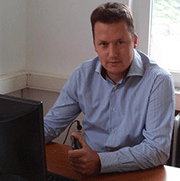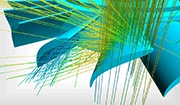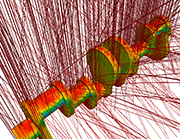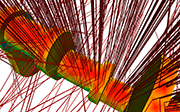E-Archive
Interview
in Vol. 15 - November Issue - Year 2014
Better Results In Shot Peening With Simulations

Mr. Miha Bav

First rebound on turbine base

Simulation on cranckshaft

Critical surfaces on cranckshaft
MFN met with Mr. Miha Bavèar, Design Department Manager of GOSTOL TST Company, an International producer of shot blasting equipment, to talk about the research and development of their products. We also had a chance to see some of their collaborations with customers.
(?) MFN: What kind of management does your company practice?
(!) M.B.: ''The rule for efficient team management is 1+1+1=111''.
The team is composed of a group of experts and customer representatives. For custom-made solutions, we include the customer from the beginning of the project. The team consists of the head of the R&D department, a sales manager, and the customer R&D representative. Our great advantage is that we listen to our customers' problems and wishes.
This working method is designed to build the best solutions for the customer. The result of the team at the end of the project is better than if you simply added up contributions and interests of all the individuals who are in the team.
(?) MFN: What is the most complicated calculation that could be done by your R&D department?
(!) M.B.: Over the years, we always want to know (at a micro level) the process of shot peening. We developed different methods of simulations. The program is custom made (exclusive to our company), and it is some combination between DEM and FEM analyses. The program was made by scientists in UNG. With this program, we are a big step ahead of our competitors. Now we can simulate different cases and show the efficiency of shot peening. In particular, we focus on the automotive and aerospace industries.
(?) MFN: Can you describe what is happening in shot peening at the micro-level?
(!) M.B.: Dynamic movement of blasting media in the shot peening process is very difficult to describe. For that reason, we have studied the process at the micro level. We understand how shot peening is a bombarding of the surface with a metal (or ceramic) component, with multiple shots at high velocities. Each piece of shot that strikes the material acts as a tiny peening hammer, imparting to the surface a small plastic indentation surrounded by a plastic zone. Once contact between the shot and the target has ceased, the elastically stressed region tends to recover to the fully unloaded state, while the plastically deformed region retains some permanent deformation. These inhomogeneous elastic-plastic deformations result in the development of a compressive residual stress field in the exposed upper layer. The layer of compressive residual stress reduces the likelihood of premature failure of the metal component under conditions of cyclic loading.
(?) MFN: Is your R&D team able to simulate the shot peening process?
(!) M.B.: We have a lot of experience with the shot peening process. We developed a special program to simulate the process in real life. We get shear stress information as a result. We can also provide information about the first and second rebounds of shoots, as well as that concerning in which part the velocity of the shot media will be worn. At the beginning of each project, we determine the relationship of shot peening's main parameters: flow directions of turbines, shot media (hardness, size, shape) and the hardness of shot peening material (target). With these input data and experience, we can provide the shear stresses, deformations, and input of energy. With these consequent parameters, we can develop better machines with much more effective shot blasting. We can see the rebounds, and with this data, we place shear protection on an exact location.
(?) MFN: Do you think that this unconventional process of shot peening will replace classic processes?
(!) M.B.: For specific industries (coil springs, etc.), the classic shot peening method is even better than unconventional ones. The laser peening method is better for the aerospace industry, as the peening is more controlled. We are working on developing a machine with LSP (laser shock peening). The process is easier to control. All the movements are made by a robotic cell. The benefits of LSP are increased components' resistance to failure mechanisms (stress, corrosion, fatigue, etc.) and reduced residual stresses with thermal relaxation. The fatigue life (cycles) is (average) more than 10x greater under the same stresses. With the different parameters (wavelength 10-18-2, etc.), we place more in-depth material stress than with conventional shot peening. The process is such that on certain parts (that we are peening) we create a water "tamping layer" and with high laser energy laser ablation surface tape for creating the plasma zone. We generate the peening effect with a shock wave. For each field, we make a matrix of hot spots. In cooperation with international robot cell producers and scientists from the faculty of electrical engineering, we are preparing to produce this laser shot peening machine as described above.
(?) MFN: Did you compare the results with real tests?
(!) M.B.: Our R&D department is constantly studying and comparing the simulated project with completed projects. For all the projects, we compare the results. The results are virtually the same.
(?) MFN: What is the latest reference where you used that simulation?
(!) M.B.: The project is in the automotive sector, where the customer is looking for the best solution, and the results of conventional methods do not satisfy him. With the simulations, we will improve energy entry to specific places, and with the achieved results, we will be able to choose the best places for blasting nozzles or blasting wheels.
(?) MFN: Last year your company developed the new Ir long-life multi-option wheel. How is the market reacting?
(!) M.B.: We have been selling the new wheel for 1 year now. We sold many wheels as installed in new machines or as second installations (replacing old turbines). The results are very good. With our improvements, we have increased their efficiency.
Energy costs are rising, and for companies that work in multiple shifts, it is important to reduce these as much as possible. The main savings are in the following areas:
Energy savings depend on the number of wheels, working hours, and price of electricity.
Wear parts of Ir wheels have life spans of 2,000 hours. This means less changing of spare parts, fewer interruptions of the production cycle, and costs savings on wear wheel parts.
Gostol TST spare parts have lower prices than spare parts of the blasting wheels that were previously installed in the blasting machine.
(?) MFN: What was your last 'second installation' for a throwing wheel?
(!) M.B.: We successfully changed four throwing wheels on shot-peening machines for blasting automotive crankshafts. Together with the R&D department, we custom-made the control cage and impeller. With these solutions, we reduced the blast cycle from 18 seconds to 13 seconds. We also made a big step with the efficiency of the throwing wheel. We were able to change the throwing wheel power from 45kW to 30kW with better results. By the way, we always use IE3 electric motors.
(?) MFN: Did you also make a simulation of blasting for that case?
(!) M.B.: Yes. For the existing blasting machine, we made a 3D model. We imported our throwing wheels and start simulations. We discovered that the old positions were not efficient for blasting crankshafts. With the calculation, we also simulated the rotation of crankshafts. With these simulations, we discovered the new dimensions for our shot blasting machine.
(?) MFN: Is it possible to have any innovations to the throwing wheel?
(!) M.B.: We have many innovations on throwing wheels. All these innovations will be presented at GIFA 2015. The innovations will bring a big step in the maintenance of throwing wheels. All readers are welcome.
(?) MFN: Can you describe the key for developing good machines?
(!) M.B.: For the development of new products, one of the key factors is passion. For each machine that leaves the company, we feel that we have entered our special certain note. We understand the importance of a well-made machine.
Passion is in every step in our company. Employees follow new trends in blasting techniques. Passion is a strong presence in us; without it, it is impossible to produce good machines.
(?) MFN: What about the future, where do you see your company heading?
(!) M.B.: Gostol TST d.d. is a company well known for its innovation and its own brand in the defined markets. We are a well-known producer of shot blasting machines in Europe, and through them, we are also globally present. With solutions, which are made based on customer demands, we produce reliable and quality shot blasting machines. We will become one of the leading producers in the production and sale of shot blasting machines in Slovenia, Europe and Eastern European markets. We are looking for wider markets, and want to become a model employer with motivated employees. Our intention is to become an important supplier of solutions for the automobile and aerospace industries.
MFN would like to thank Mr. Bavèar for the interview, we wish you great success!
For Information:
Gostol TST d.d.
Ciginj 63, 5220 Tolmin, Slovenia
Tel. +386.5.380 12 80
Fax +386.5.380 12 90
E-mail: sales@gostol-tst.eu
www.gostol-tst.eu



























